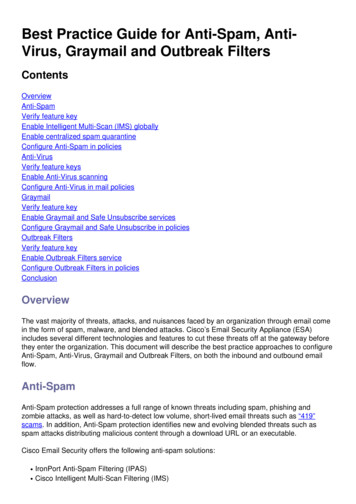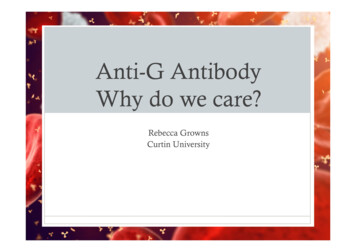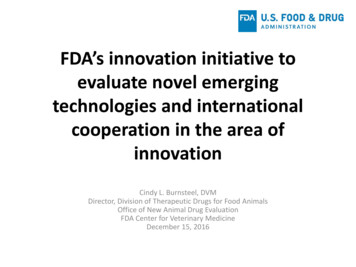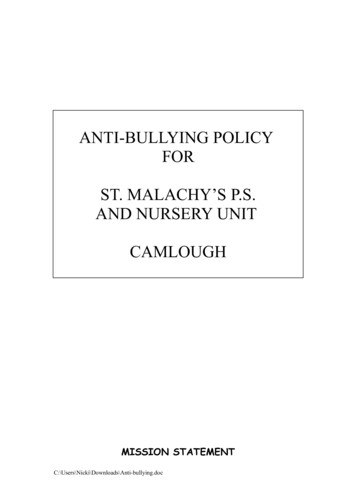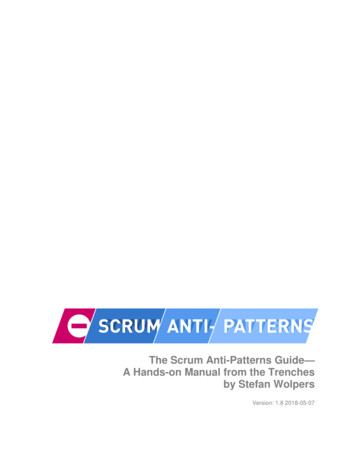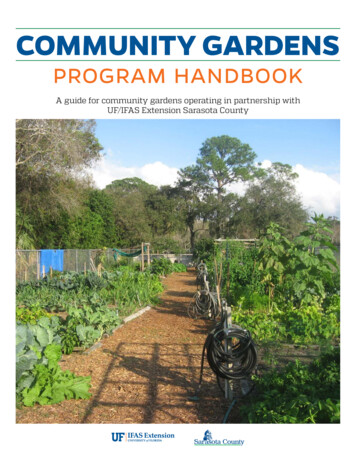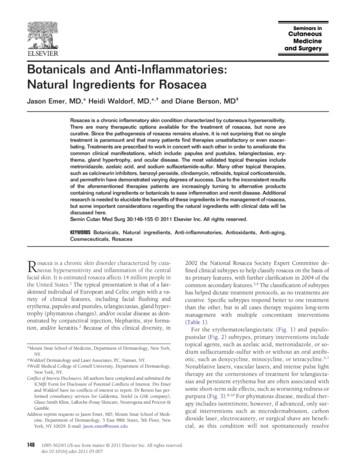
Transcription
Botanicals and Anti-Inflammatories:Natural Ingredients for RosaceaJason Emer, MD,* Heidi Waldorf, MD,*,† and Diane Berson, MD‡Rosacea is a chronic inflammatory skin condition characterized by cutaneous hypersensitivity.There are many therapeutic options available for the treatment of rosacea, but none arecurative. Since the pathogenesis of rosacea remains elusive, it is not surprising that no singletreatment is paramount and that many patients find therapies unsatisfactory or even exacerbating. Treatments are prescribed to work in concert with each other in order to ameliorate thecommon clinical manifestations, which include: papules and pustules, telangiectasias, erythema, gland hypertrophy, and ocular disease. The most validated topical therapies includemetronidazole, azelaic acid, and sodium sulfacetamide-sulfur. Many other topical therapies,such as calcineurin inhibitors, benzoyl peroxide, clindamycin, retinoids, topical corticosteroids,and permethrin have demonstrated varying degrees of success. Due to the inconsistent resultsof the aforementioned therapies patients are increasingly turning to alternative productscontaining natural ingredients or botanicals to ease inflammation and remit disease. Additionalresearch is needed to elucidate the benefits of these ingredients in the management of rosacea,but some important considerations regarding the natural ingredients with clinical data will bediscussed here.Semin Cutan Med Surg 30:148-155 2011 Elsevier Inc. All rights reserved.KEYWORDS Botanicals, Natural ingredients, Anti-inflammatories, Antioxidants, Anti-aging,Cosmeceuticals, RosaceaRosacea is a chronic skin disorder characterized by cutaneous hypersensitivity and inflammation of the centralfacial skin. It is estimated rosacea affects 14 million people inthe United States.1 The typical presentation is that of a fairskinned individual of European and Celtic origin with a variety of clinical features, including facial flushing anderythema, papules and pustules, telangiectasias, gland hypertrophy (phymatous changes), and/or ocular disease as demonstrated by conjunctival injection, blepharitis, stye formation, and/or keratitis.2 Because of this clinical diversity, in*Mount Sinai School of Medicine, Department of Dermatology, New York,NY.†Waldorf Dermatology and Laser Associates, PC, Nanuet, NY.‡Weill Medical College of Cornell University, Department of Dermatology,New York, NY.Conflict of Interest Disclosures: All authors have completed and submitted theICMJE Form for Disclosure of Potential Conflicts of Interest. Drs Emerand Waldorf have no conflicts of interest to report. Dr Berson has performed consultancy services for Galderma, Stiefel (a GSK company),Glaxo Smith Kline, LaRoche-Posay Skincare, Neutrogena and Proctor &Gamble.Address reprint requests to Jason Emer, MD, Mount Sinai School of Medicine, Department of Dermatology, 5 East 98th Street, 5th Floor, NewYork, NY 10029. E-mail: Jason.emer@mssm.edu1481085-5629/11/ -see front matter 2011 Elsevier Inc. All rights reserved.doi:10.1016/j.sder.2011.05.0072002 the National Rosacea Society Expert Committee defined clinical subtypes to help classify rosacea on the basis ofits primary features, with further clarification in 2004 of thecommon secondary features.3,4 The classification of subtypeshas helped dictate treatment protocols, as no treatments arecurative. Specific subtypes respond better to one treatmentthan the other, but in all cases therapy requires long-termmanagement with multiple concomitant interventions(Table 1).For the erythematotelangiectatic (Fig. 1) and papulopustular (Fig. 2) subtypes, primary interventions includetopical agents, such as azelaic acid, metronidazole, or sodium sulfacetamide-sulfur with or without an oral antibiotic, such as doxycycline, minocycline, or tetracycline.5-7Nonablative lasers, vascular lasers, and intense pulse lighttherapy are the cornerstones of treatment for telangiectasias and persistent erythema but are often associated withsome short-term side effects, such as worsening redness orpurpura (Fig. 3).8-10 For phymatous disease, medical therapy includes isotretinoin; however, if advanced, only surgical interventions such as microdermabrasion, carbondioxide laser, electrocautery, or surgical shave are beneficial, as this condition will not spontaneously resolve
Botanicals, antiinflammatories, and rosacea149Table 1 Subtypes of Rosacea with Associated Characteristics and Suggested taticFlushing and persistentcentral facial erythema ⴞtelangiectasiaPapulopustularPersistent central faiclaerythema with transient,central facial papules and/or pustulesThickening skin, irregularsurface nodularities andenlargement; may occur onthe nose, chin, forehead,cheeks, or earsForeign body sensation in theeye, burning or stinging,dryness, itching,photosensitivity, blurredvision, telangiectasia of thesclera or other parts of theeye, or periorbital edemaPhymatousOcularInterventionsFlushing: trigger avoidance, ice chips in mouth/drinking coldwater/cold compresses on face, clonidine, beta-blockers;nontransient erythema: topical metronidazole, azelaic acid,sodium sulfacetamide-sulfur; persistent erythema: laser(pulsed dye) and light modalities (intense pulsed)Topical metronidazole or azelaic acid ⴞ sodiumsulfacetamide-sulfur; ⴞ oral tetracyclines or low-dose oralisotretinoinOral isotretinoin ⴞ pulse dye laser; advanced cases:surgical interventions (electrosurgery, cold steel excision,carbon dioxide, scalpel or shave sculpting)Good oral hygiene, warm compresses, artificial tears; ⴞ oraltetracyclines; consider intraocular cyclosporine ophthalmic(Restasis)Adapted from: Wilkin et al.3 and Del Rosso et al.88(Fig. 4).11-13 Disease exacerbations will not improve without the patient’s strict avoidance of triggers (caffeine, exercise, spicy food, alcohol, emotional stress, topical productsthat irritate the epidermal barrier, medications that induce flushing) and appropriate adjunctive skin care, such as gentle cleansers, moisturizers, and photoprotection.14The incomplete understanding of the pathogenesis of rosacea makes treatment difficult and at times disappointing. Itis known that inflammation plays a role because most interventions that modulate the inflammatory process are effective. However, factors that regulate and maintain this inflammatory dysfunction are poorly understood. Despite all theresearch on the development of rosacea and the underlyingneoangiogenesis, pilosebaceous abnormalities, dermal matrix degeneration, and dysfunction of antimicrobial peptides,Figure 1 Erythematotelangiectatic rosacea of the left cheek. Note thecentrally located facial flushing and telangiectasias with sparing ofthe periocular skin.most therapies only target the signs and symptoms of thecondition rather than the underlying cause.15 Because eachpatient is uniquely sensitive both to triggers that stimulatedisease and to standard therapies, an increasing number ofpatients are seeking alternative options.Natural Ingredient AlternativesNatural ingredients have been used worldwide for centuriesin skin care as wound healing and antiaging remedies. Manynew dermatologic products claim to contain “natural” ingredients— botanicals that are herbal in origin and found directly in nature—with beneficial claims of activity on agingand inflammation (Fig. 5). They provide alternatives for pa-Figure 2 Papulopustular rosacea with predominately small erythematous papules and pustules.
J. Emer, H. Waldorf, and D. Berson150Figure 3 Erythema and purpura after pulsed-dye laser treatment oferythematotelangiectatic rosacea.tients frustrated with standard prescription medications butmay also be used to enhance the therapeutic effects or prevent the side effects of other medications. Because herbal andother alternative medical treatments are used by more thanhalf the population in the United States, it is important thatdermatologists have knowledge of common and popular botanicals used medicinally or for flavoring and/or fragrances.16,17Large, clinically validated, placebo-controlled trials arelacking, most likely because medicinal botanicals used incosmeceuticals are considered food additives or dietary supplements by the U.S. Food and Drug Administration (FDA)and can be marketed without maintaining any drug status orrestriction. A high level of scrutiny is needed because most“natural” treatments have no standards in potency, concen-Figure 4 Phymatous rosacea is characterized by marked skin thickening and irregular surface nodularity.Figure 5 Examples of products containing natural (botanic) ingredients, such as soy, oatmeal, niacinamide, vitamins, and minerals.tration, safety, or efficacy. Despite many herbal remediesclaiming dermatologic benefits, only colloidal oatmeal, niacinamide, feverfew, licorice extract, green tea, and coffeeberryhave scientific literature suggesting a therapeutic advantagein the treatment of rosacea (Table 2). These products will bethe primary focus of this paper, with a brief mention of otherbotanicals on the market.HydratingColloidal OatmealColloidal oatmeal has a long-standing history of benefit indermatologic conditions associated with itch and irritationbecause of ability to soothe and protect inflamed skin. Itcontains a variety of active components, including polysaccharides, proteins, lipids, saponins, enzymes, flavonoids, vitamins, and avenanthramides (polyphenol).18 In 1989, theFDA recognized the value of colloidal oatmeal as a safe andeffective skin protectant. In 2003, colloidal oatmeal becamean approved over-the-counter monograph ingredient.19 Current, ready-to-use oatmeal preparations are the concentratedstarch-protein fraction of the oat grain mixed with emollient.18 Fine particles disperse on the skin and form a protective, occlusive barrier that retards water loss and moisturizesto help improve the epidermal barrier. Further, oatmeal saponins help to solubilize dirt, oil, and sebaceous secretionswhich may normalize the skin pH.20 Oats have importantantioxidant, ultraviolet (UV) absorbent, and antiinflammatory properties attributed to the ferulic, caffeic, and coumaricacids, as well as flavonoids and -tocopherol (vitamin E)components.21,22 Recent research has identified avenanthramides (phenolic compounds) as a minor component of oatgrains, and in vitro work, researchers have demonstratedantiinflammatory and antipruritic properties by decreasedproduction of NF-kappaB (NF-kB) in keratinocytes and reduced proinflammatory cytokine (eg, IL-8) production.23,24Avenanthramides have also been reported to inhibit prostaglandin synthesis.25 As a result, many studies have substan-
Botanicals, antiinflammatories, and rosacea151Table 2 Natural Ingredients in the Treatment of RosaceaProductSourceActive ComponentColloidal oatmealAvena sativaNiacinamideFeverfewLicoriceTeasVitamin B3 found in foods (meat, fish, wheat)Tanacetum partheniumGlycyrrhiza glabra, Glycyrrhiza inflataCamellia sinensisCoffeeberryCoffea arabicaAloe veraAloe veraChamomileTumericMushroomextractsMatricaria recutita, Chamaemelum nobileCurcuma longaLentinula edodes, Ganoderma lucidumtiated the antiinflammatory, hydrating, and antipruriticproperties of colloidal oatmeal and their use in the management of common inflammatory dermatoses, such as atopicdermatitis. Although additional research is needed to explainits use in other conditions, the data suggest that colloidaloatmeal may be a useful ingredient in cleansers or moisturizers used for rosacea.Anti-inflammatoriesNiacinamideNiacinamide (also known as nicotinamide) is the amide ofnicotinic acid (vitamin B3 or niacin), which is a water-solublevitamin found in meat, fish, and wheat. It does not have thesame pharmacologic and toxic effects of niacin, which occursincidentally during biochemical conversion. Therefore, niacinamide does not cause flushing, itching, burning, or areduction in serum cholesterol but does work in oxidationreduction pathways of nicotinamide adenine dinucleotideand nicotinamide adenine dinucleotide phosphate.26 Niacinamide acts as an antioxidant but also possesses biologicalactivities, making it an important emerging cosmetic ingredient.27 Niacinamide has antiinflammatory action, skinlightening properties, and can decrease the production ofsebum; thus, it may be of benefit to patients with inflammatory skin conditions.28A recent open-label, multicenter, prospective cohortstudy was conducted to assess the clinical utility of oralpharmacologic doses of nicotinamide and zinc in 198 patients with acne vulgaris and/or rosacea.29 The basis forthis investigation was a variety of potential mechanisms ofaction of nicotinamide and zinc, including: (1) an antiinflammatory effect via inhibition of leukocyte chemotaxis,lysosomal enzyme release, lymphocytic transformation,and mast cell degranulation; (2) bacteriostatic effectagainst Propionibacterium acnes; (3) inhibition of vasoactive amines; (4) preservation of intracellular coenzymehomeostasis; and (5) decreased sebum production.30 Thestudy’s primary efficacy measures were patient global eval-Polysaccharides, proteins, lipids, saponins, enzymes,flavonoids, vitamins, avenanthramidesN/AVolatile oils, flavonoids, sesquiterperne lactonesGlabridin, licochalcone APolyphenols: epigallocatechin gallate (EGCG) andepicatechin gallate (ECG)Polyphenols: chlorogenic acid, proanthocyanidins,quinic acid, ferulic acidSalicylic acid, magnesium lactate, gelpolysaccharidesTerpenoids, flavonoidsCurcuminPolysaccharides, teriperpenes, proteins, lipids,phenols, cerebrosidesuation and patient evaluation of the percentage reductionin inflammatory lesions after 4 and 8 weeks of treatment;overall patient satisfaction also was recorded. The studyformulation consisted of nicotinamide, 750 mg; zinc, 25mg; copper, 1.5 mg;, and folic acid, 500 g.After 4 weeks, the number of patients enrolled who reported improvement was significantly greater (P 0.0001)than the number who reported either no change in or worsening of their condition. Seventy-nine percent of patientsreported improvement in appearance as moderately better ormuch better, as measured by patient global evaluation. Fiftyfive percent reported moderate (26%-50% reduction in lesions) or substantial ( 50% reduction in lesions) improvement after four weeks of treatment (P 0.0001). Thepercentage of patients who responded to therapy continuedto increase through the 8 weeks of treatment. When patientswho received concomitant oral antibiotic therapy (51/198,26%) are compared with those who received vitamin tabletsas monotherapy (147/198, 74%), the percentage of patientswho responded to treatment was not significantly differentbetween treatment groups (P 0.13). This finding was particularly interesting given that most patients studied considered their condition to be of at least moderate severity (143/198, 72%). The conclusion was that niacinamide and zincwere effective for the treatment of acne vulgaris and rosaceawhen used alone or with other therapies and should be considered as useful alternatives or adjuncts.It has recently been shown that topical application of niacinamide has a stabilizing effect on epidermal barrier function, seen as a reduction in transepidermal water loss and animprovement in the moisture content of the horny layer.31Niacinamide increases protein synthesis (eg, keratin), stimulates ceramide synthesis, potentiates the differentiation ofkeratinocytes, and increases intracellular nicotinamide adenine dinucleotide phosphate levels. Given these findings, it ishypothesized that topical application of niacinamide mayimprove surface structure, reduce rhytides, inhibit photocarcinogenesis, and demonstrate antiinflammatory effects inacne and/or rosacea.26,32,33
J. Emer, H. Waldorf, and D. Berson152FeverfewFeverfew (Tenaceetum parthenium), a member of the Asteraceae family and species-specific dried chrysanthemumleaves, is a medicinal herb used traditionally to reduce feverand treat headache, arthritis, and digestive problems.34,35 Theperennial flowering plant has citrus-scented leaves and isreminiscent of daisies. It has potent antiinflammatory, antioxidant, and anti-irritant properties. Its main componentsare volatile oils (L-camphor, linalool, terpenes), flavonoids,and sesquiterpene lactones (parthenolides). Feverfew inhibits 5-lipoxygenase and cyclooxygenase, resulting in a reduction in platelet aggregation and parthenolides inhibit serotonin release from platelets.36 Topical use of feverfew hadbeen limited by the potent irritant effects of parthenolides.However, an industry patented process was developed allowing removal of parthenolides. As a result, feverfew PFE(Aveeno; Johnson and Johnson Consumer Companies, Inc,New Brunswick, NJ), a purified feverfew extract, was developed to reduce facial redness and skin irritation by inhibitingthe release of inflammatory markers from activated lymphocytes and reducing neutrophil chemotaxis.37-39 Feverfew PFEhas been shown to possess antioxidative and antiinflammatory properties by (1) inhibiting proinflammatory mediatorsreleased from macrophages (nitric oxide, PGE2, tumor necrosis factor-alpha) and human blood monocytes (tumor necrosis factor-alpha, interleukin [IL]-2, IL-4, and interferon- );(2) reducing neutrophil chemotaxis; (3) reducing NF-kBdependent gene transcription; and (4) inhibiting the releaseof IL-8 and adhesion molecules expressed from keratinocytes.40-42 This purified extract has been studied and hasdemonstrated protective effects from UV exposure and irritation, improvements in facial redness, blotchiness, and tactile roughness, and reduction in irritation seen from shaving.38,43,44Licorice ExtractLicorice (Glycyrrhiza glabra and Glycyrrhiza inflata) plantshave been long used in alternative medicine for the treatmentof a variety of inflammatory conditions as the result of theirpresumptive healing powers. Glycyrrhiza glabra containsglabridin, and Glycyrrhiza inflata contains licochalcone A,both of which have anti-irritant and anti-inflammatory properties.45,46 Studies have shown that licorice reduces inflammation, promotes mucous secretion, soothes irritation, andstimulates adrenal gland activity.47 In addition, licorice appears to exert immunomodulatory effects by regulating cytokines and interferon and thus, may have antiviral and antimicrobial activity.48-50Licorice extract is produced by boiling licorice root andsubsequently evaporating the water. The main componentsof the extract include triterpene saponins, flavonoids, andisoflavonoids.45 Licorice appears to have antiinflammatoryproperties because of inhibition of superoxide anion production and cyclooxygenase activity.46 In a laboratory studycomparing the antioxidant activity of Glycyrrhiza to antioxidants in commercial 2% hydroquinone, researchers demon-strated superior antioxidant activity of the licorice extract at0.5% and 1% concentrations.51The anti-inflammatory and antioxidant activity of licoricesuggests skin care benefits in patients with sensitive skin. Inone study, topical preparations (1% and 2%) were evaluatedfor the treatment of atopic dermatitis in a double-blind clinical trial in comparison with a base gel. Two percent licoricetopical gel significantly decreased scores of erythema, edema,and itching over 2 weeks.52 Another study of a skin careregimen containing licochalcone A (Eucerin Redness Relief;Beiersdorf, Inc, Hamburg, Germany), a retrochalcone derived from Glycyrrhiza inflata, demonstrated improvementsin mean erythema and quality-of-life scores at 4 and 8 weeksin patients with mild-to-moderate facial redness and werecomparable in efficacy with topical metronidazole and azeliac acid.53 In another study, application of a licochalconeA-containing extract twice daily for 3 days was associatedwith significant reduction in shaving-induced and UV-induced erythema compared with vehicle control in e, green, oolong, and black teas are derived from theleaves and buds of the tea plant (Camellia sinensis) and contain potent antioxidant, anti-inflammatory, and anticarcinogenic polyphenols known as catechins.54-56 Green tea polyphenols, particularly epigallocatechin gallate and epicatechingallate, appear to be most diverse in initiating cellular/molecular responses in the epidermis.57 The multiple effects ofgreen tea include inhibition of UV-induced tumorigenesispathways, including mitogen-activated protein kinase andactivator protein-1, as well as the infiltration of inflammatorycells. In addition, green tea possesses antioxidant propertiesby eliminating reactive oxygen species and inhibiting nitricoxide synthetase, lipoxygenase, cyclooxygenase, and lipidperoxidase. It exerts antiinflammatory activity via inhibitionof lipoxygenase and cyclooxygenase as well as by inhibitingthe infiltration of inflammatory cells, such as macrophagesand neutrophils with subsequent decrease of proinflammatory cytokines (IL-1, IL-8, IL-10, IL-12). Finally, it is anticarcinogenic by inhibiting carcinogen-DNA binding and subsequent tumorigenesis.Besides the antiinflammatory and antioxidant properties,which make green tea useful in the treatment of rosacea, theprotection it affords from UV light makes it particularly useful as rosacea is often triggered by light exposure. Topicalapplications of green tea (epigallocatechin gallate and epicatechin gallate) have been shown to decrease UV-induced erythema and to reduce DNA damage as demonstrated by measuring cyclobutane pyrimidine dimers.58-60 These studiesdemonstrate the chemoprotective effect of green tea extractsand suggest a natural alternative for photoprotection andpossibly a treatment for UV-induced rosacea. Green tea mayalso directly improve the signs of rosacea by reducing the
Botanicals, antiinflammatories, and rosacea153number and appearance of telangiectasias and minimize thedisruption of the skin barrier.55lar permeability on the aloe vera-treated group, suggesting arole in inflammatory skin conditions, such as rosacea.77Coffeeberry and CaffeineChamomileExtracts of the coffee plant (Coffea arabica) have been shownto exhibit antioxidant activity. It has recently been discoveredthat the fruit of the coffeeberry plant has effective antioxidantactivity.61 Coffeeberry contains potent polyphenol compounds, including chlorogenic acid, proanthocyanidins,quinic acid, and ferulic acid.37 These polyphenols help toprevent damage caused by free radical exposure and oxidative stress and have been shown to protect against UVA andUVB radiation.62,63 Testing by oxygen radical absorbance capacity demonstrates 10-15 times the antioxidant capacity asgreen tea extract, pomegranate, vitamin C, and vitamin E.64Although no conclusive clinical studies assessing topicalpreparations containing Coffea arabica or coffeeberry extracthave been performed, preliminary evidence suggests that thisextract produces improvement in hyperpigmentation, finelines, and overall skin appearance.37,65 The Coffea arabicaplant is regarded as safe.66 Current preparations represent awell-tolerated choice for rosacea patients who desire an antiaging regimen. Anecdotally, many of these patients experience a reduction in facial erythema.Caffeine extracted from the leaves of the Coffea arabicaplant has been used in some botanic formulations as an activeingredient.67 Caffeine is known to cause dehydration of fatcells by acting directly to promote lipolysis, inhibit phosphodiesterase, and thus augment cyclic adenosine monophosphate. These characteristics plus its stimulatory effect on cutaneous microcirculation have been used to support topicalcaffeine as a treatment for lower eyelid puffiness and cellulite.68,69 Of note, although oral consumption of caffeine hadpreviously been regarded as a risk factor for rosacea activity, a recent study demonstrated only photosensitive skintypes, a positive family history of rosacea, or previoussmoking status as risk factors compared with healthy control patients.70 Reports of dermatitis and/or allergic reactions to caffeine in the literature are more likely because ofvolatile oils found in the coffee grains or added preservatives and fragrances in the topical preparations rather thanfrom the caffeine itself.71Chamomile (Matricaria recutita and Chamaemelum nobile) hasactive components of terpenoids (bisobolol, matricin, andchamazulene) and flavonoids (apigenin, luteolin, and quercetin) in its volatile oils that inhibit cyclooxygenase and lipoxygenase as well as regulate the T helper cell (Th2) activation and histamine release.78,79 Topical applications havebeen shown to be beneficial in atopic dermatitis and skinirritation.80 One study documented the anti-inflammatoryeffect of topical application to be approximately 60% of thatproduced by hydrocortisone 0.25%.81 Chamomile can potentially induce allergic contact dermatitis because it is amember of the ragweed family; therefore, caution is warranted with use on sensitive skin even though it is thought tohave soothing effects.Other BotanicalsAloe VeraAloe vera is thought to have antiinflammatory, analgesic, antipruritic, and wound-healing properties.72,73 Its active components include salicylic acid (antiinflammatory via thromboxane and prostaglandin inhibition), magnesium lactate(antipruritic via histidine decarboxylase inhibition), andgel polysaccharides (anti-inflammatory via immunomodulation).44 Aloe vera has been studied with success in the treatment of psoriasis and case reports have noted a reduction inburning, itching, and scarring associated with radiation dermatitis.74-76 One study on burn-wound rats demonstratedsignificant decreases in vasodilation and postcapillary vascu-TumericTumeric (Curcuma longa) has a long-standing history of usein Asian cuisine and is best known for its active componentcurcumin which is reported to have anti-inflammatory, antioxidant, wound healing, and chemopreventive properties.44,82 Odor and color limit its incorporation into manytopical treatments.MushroomExtracts from mushrooms, such as shiitake (Lentinula edodes)and reishi (Ganoderma lucidum), contain several compounds(polysaccharides, triterpenes, proteins, lipids, phenols, andcerebrosides) of interest for their potent anti-inflammatoryand antioxidant properties.83,84 Main mechanisms of actioninclude the inhibition of lipid peroxidation, superoxide dismutase, metalloproteinases, and proinflammatory cytokines(IL-8), as well as the promotion of free radical scavenging.85 Itis also thought that shiitake mushroom complexes inhibitelastase and activator protein-1, which breaks down collagen, forming the basis for its use in antiaging treatments.86Overconsumption of shiitake mushroom has been documented to cause flagellate dermatitis.87Expert Opinion and PearlsAs we have learned more about the pathogenic factors contributing to this complex condition, it is clear that inflammation, inflammatory mediators, and subsequent oxidativedamage play a role. The use of anti-inflammatory and antioxidant ingredients, such as those found in botanic products,provide helpful adjuncts to traditional therapies. We oftenchoose products that contain soy, niacinamide, green tea, orfeverfew for improving erythema. These products seem tocalm the inflammation of rosacea by providing barrier protection and exerting antioxidant and anti-inflammatory effects.When initiating botanic therapy for rosacea, we recommend spot testing a small area (such as pre- or postauricular)
154before full-face use. We then integrate the new topical intothe treatment regimen slowly. Patients with rosacea havemore sensitive and reactive skin and even a delicate change intherapy can exacerbate the condition. Furthermore, it is ofthe utmost importance to recommend sunscreens to everypatient. Chemical blockers (i.e., octylcrylene, avobenzone,and oxybenzone) may be irritating and we prefer physicalblocking agents (i.e., titanium dioxide and zinc oxide). Patients should avoid oil-based topical products, topical corticosteroids, and minimize exposure to hot or spicy foods,alcohol, hot environs, and flush-inducing medications.Lastly, patients should be informed that no topical therapiesare effective for telangiectasias, and those with cosmetic concerns can be offered vascular laser or intense pulsed lighttherapy.ConclusionsRosacea patients are increasingly seeking natural alternativesto traditional prescription treatments. Although some naturalproducts show promise, research is limited and further investigation is needed to validate the quality of these ingredients. It is not known whether these products are useful adjuvants or actual alternatives to commonly prescribedtreatments. It appears that the theoretic value comes fromtheir inherent anti-inflammatory, anti-irritant, and antioxidant nature. Dermatologists must be aware of what is available and what their patients are using to better coordinate thelong-term management of chronic inflammatory conditionslike rosacea.References1. Crawford GH, Pelle MT, James WD: Rosacea: I. Etiology, pathogenesis,and subtype classification. J Am Acad Dermatol 51:327-341, 20042. Dahl MV: Pathogenesis of rosacea. Adv Dermatol 17:29-45, 20013. Wilkin J, Dahl M, Detmar M, et al: Standard classification of rosacea:Report of the National Rosacea Society. Expert Committee on the Classification and Staging of Rosacea. J Am Acad Dermatol 46:584-587,20024. Wilkin J, Dahl M, Detmar M, et al: Standard grading system for rosacea:Report of the National Rosacea Society Expert Committee on the Classification and Staging of Rosacea. J Am Acad Dermatol 50:907-912,20045. Pelle MT, Crawford GH, James WD: Rosacea: II. Therapy. J Am AcadDermatol 51:499-512, 20046. Odom R, Dahl M, Dover J, et al: Standard management options forrosacea, part 2: options according to subtype. Cutis 84:97-104, 20097. van Zuuren EJ, Gupta AK, Gover MD, et al: Systematic review of rosaceatreatments. J
in the treatment of rosacea (Table 2). These products will be r botanicals on the market. Hydrating Colloidal Oatmeal Colloidal oatmeal has a long-standing history of benefit in dermatologic conditions associated with itch and irritation because of ability to soothe and protect inflamed skin. It
